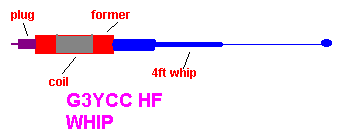

I thought it may be of interest to describe simple to make HF whip antennas I have experimented with and used for a while.
The above picture demonstrates the idea; a simple base loaded quarter wave vertical, which can be used on a car, employing the car as the ground or earth, whereas a counterpoise or radial/s can be used 'in the field'.
For portable use, the whip part can be telescopic, and a beautiful telescopic ex-army whip is available in the UK from John Birkett (Lincoln), which retails for only one pound! These telescope from 6 inches up to nearly 4 feet and come complete with a useful mount akin to a jack socket. For a mobile version, I use a 4 foot steel whip, non-telescopic. I used my 20m mobile version mounted on a large mag mount and it worked well with 10 watts p.e.p.
CONSTRUCTION
Hopefully the general idea can be seen from the pictures, but, basically the loading coil is connected at the bottom to the centre of the plug, the outer of which goes to ground/counterpoise. The top of the coil goes to the bottom of the whip, telescopic or not. A good strong former is required to take the loading coil and support the whip satisfactorily. I found a good material for the former is glass fibre tubing about 3/4" diameter. I leave you to decide for yourself how to mount the plug at the base of the antenna and the whip at the top - I find Araldite and fibre glass compound as good as any, but remember, you have to solder the wire to the plug and whip first! I usually drill a small hole through the former, solder to the plug and whip a short length of insulated wire, thread through the holes before mountingthe two parts permanently in the glass fibre tube, which typically is about 6" long. The wire for the loading coil is 24 s.w.g enamelled copper and as a rough guide, I find about 30 turns close wound on the 3/4" former will be somewhere near for 20m, and you will have to experiment for other bands, maybe 50 - 60 turns for 40m. The 'tricky' part of the excercise is the tuning, so I will try and describe my method.
TUNING THE WHIP
Mount the whip in it's operating position, on the car or other mount. An idea for portable use is to a large car battery type crocodile clip, with a suitable base mounted on it. The counterpoise can be clipped on with a small croc. clip, say 17 feet for 20m. Now for the tuning!
What I do, is to run coax from the socket holding the whip and run to a QRP rig via an SWR bridge. Tune to the centre of the band and listen to the band noise. Approach your hand to the loading coil and note if the noise gets louder or softer. If it gets loader, you need more inductance or capacitance, i.e more turns or more whip. This is a rough way to get it somewhere near, then apply RF via the SWR bridge and repeat watch what happens to the reflected power as you appoach your hand to the coil (CARE - DO NOT TOUCH IT! RF HURTS!). If the swr goes down with the hand nearer, add more whip if telescopic, or more coil and vice versa. You will find as you get near resonance that just by altering the wire spacing in the coil,an optimum SWR can be attained. Carefully fix the coil by covering with PVC tape or heatshrink. For a mobile whip, if you persevere, you can tune the antenna satisfactorily with a fixed length whip, just by playing with the coil turn spacing, so that when you come to use it on say, a mobile mag mount, you just screw it on, connect to the rig and operate! No tuning needed or possible, unless used well away from resonance. In this case, you can tune a fixed whip with another little tip I'll pass on! I use a short lenghth of thick copper wire soldered to a movable connector on the whip, which is adjusted to suit and fixed with a grub screw. One of the inners from cable connectors can be employed, or whatever you have to hand. An antenna analyzer makes tuning a snip as you can follow resonance as you make adjustments, whereas, using the SWR method, only in band indication is possible. You can get pretty near by the audible signal method described earlier.
Have fun and I hope you follow my description!
Frank, G3YCC.